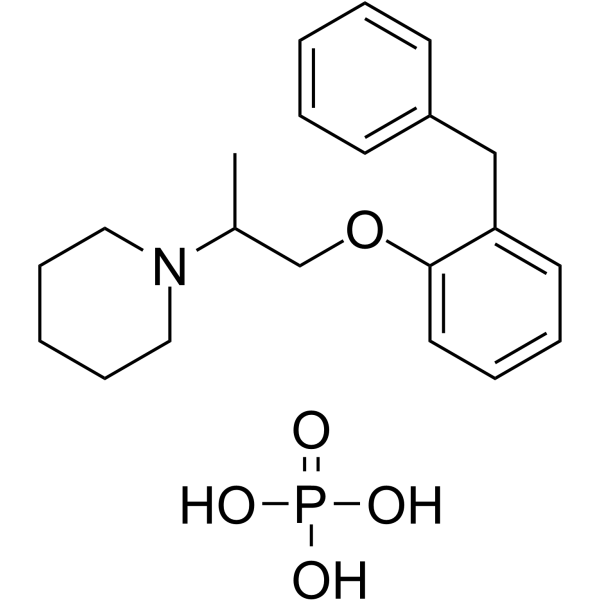Physicochemical Properties
| Molecular Formula | C21H30NO5P |
| Molecular Weight | 407.44 |
| Exact Mass | 407.186 |
| CAS # | 19428-14-9 |
| PubChem CID | 167811 |
| Appearance | White to off-white solid powder |
| Boiling Point | 433ºC at 760mmHg |
| Melting Point | 148-153ºC |
| Vapour Pressure | 1.06E-07mmHg at 25°C |
| LogP | 3.539 |
| Hydrogen Bond Donor Count | 3 |
| Hydrogen Bond Acceptor Count | 6 |
| Rotatable Bond Count | 6 |
| Heavy Atom Count | 28 |
| Complexity | 370 |
| Defined Atom Stereocenter Count | 0 |
| InChi Key | MCVUURBOSHQXMK-UHFFFAOYSA-N |
| InChi Code | InChI=1S/C21H27NO.H3O4P/c1-18(22-14-8-3-9-15-22)17-23-21-13-7-6-12-20(21)16-19-10-4-2-5-11-19;1-5(2,3)4/h2,4-7,10-13,18H,3,8-9,14-17H2,1H3;(H3,1,2,3,4) |
| Chemical Name | 1-[1-(2-benzylphenoxy)propan-2-yl]piperidine;phosphoric acid |
| HS Tariff Code | 2934.99.9001 |
| Storage |
Powder-20°C 3 years 4°C 2 years In solvent -80°C 6 months -20°C 1 month Note: Please store this product in a sealed and protected environment, avoid exposure to moisture. |
| Shipping Condition | Room temperature (This product is stable at ambient temperature for a few days during ordinary shipping and time spent in Customs) |
Biological Activity
| ln Vitro | In a dose-dependent manner, benproperine phosphate (20–120 μM) reduces cell viability for 24 hours [1]. Benproperine phosphate (10 μM; 24 hours of action) has an IC50 value of 1-2 μM and strongly inhibits the migration of different cancer cells, as well as the migration and invasion of DLD-1 and AsPC-1 cells. In MCF-10A cells, benproperine phosphate (10 μM; 24 hours) has no effect on cortactin-rich lamellipodia [1]. |
| ln Vivo | The growth of primary pancreatic tumors is inhibited by benproperine phosphate (50, 100 mg/kg; oral gavage; 5 days per week for 4 weeks)[1]. Benproperine phosphate (56.1% inhibition) dramatically decreased the lung metastasis of mouse AsPC-1 cells. Benproperine phosphate reduced HCT-116 and DLD-1 cells' ability to spread to the liver by 78.9% and 78.2%, respectively[1]. |
| Cell Assay |
Cell Viability Assay[1] Cell Types: DLD-1, AsPC-1, CFPAC-1, A375P, A375P, MDA-MB-231, DU145, DU145 cancer cells Tested Concentrations: 20, 40, 60, 80, 100, 120 μM Incubation Duration:For 24 hrs (hours) Experimental Results: Inhibited cell viability in a dose-dependent manner. |
| Animal Protocol |
Animal/Disease Models: Female BALB/c nude mice of 6weeks old with AsPC-1 cells[1] Doses: 50, 100 mg/kg Route of Administration: Oral gavage; 5 days per week for 4 weeks Experimental Results: Inhibited primary pancreatic tumor growth compared to the vehicle control (47.7% inhibition) without body weights change. |
| References |
[1]. Benproperine, an ARPC2 inhibitor, suppresses cancer cell migration and tumor metastasis. Biochem Pharmacol. 2019 May;163:46-59. |
| Additional Infomation | See also: Benproperine (annotation moved to). |
Solubility Data
| Solubility (In Vitro) |
DMSO: 125 mg/mL (306.79 mM) H2O: ≥ 100 mg/mL (245.43 mM) |
| Solubility (In Vivo) |
Solubility in Formulation 1: ≥ 2.08 mg/mL (5.11 mM) (saturation unknown) in 10% DMSO + 40% PEG300 + 5% Tween80 + 45% Saline (add these co-solvents sequentially from left to right, and one by one), clear solution. For example, if 1 mL of working solution is to be prepared, you can add 100 μL of 20.8 mg/mL clear DMSO stock solution to 400 μL PEG300 and mix evenly; then add 50 μL Tween-80 to the above solution and mix evenly; then add 450 μL normal saline to adjust the volume to 1 mL. Preparation of saline: Dissolve 0.9 g of sodium chloride in 100 mL ddH₂ O to obtain a clear solution. Solubility in Formulation 2: ≥ 2.08 mg/mL (5.11 mM) (saturation unknown) in 10% DMSO + 90% (20% SBE-β-CD in Saline) (add these co-solvents sequentially from left to right, and one by one), clear solution. For example, if 1 mL of working solution is to be prepared, you can add 100 μL of 20.8 mg/mL clear DMSO stock solution to 900 μL of 20% SBE-β-CD physiological saline solution and mix evenly. Preparation of 20% SBE-β-CD in Saline (4°C,1 week): Dissolve 2 g SBE-β-CD in 10 mL saline to obtain a clear solution. Solubility in Formulation 3: ≥ 2.08 mg/mL (5.11 mM) (saturation unknown) in 10% DMSO + 90% Corn Oil (add these co-solvents sequentially from left to right, and one by one), clear solution. For example, if 1 mL of working solution is to be prepared, you can add 100 μL of 20.8 mg/mL clear DMSO stock solution to 900 μL of corn oil and mix evenly. (Please use freshly prepared in vivo formulations for optimal results.) |
| Preparing Stock Solutions | 1 mg | 5 mg | 10 mg | |
| 1 mM | 2.4543 mL | 12.2717 mL | 24.5435 mL | |
| 5 mM | 0.4909 mL | 2.4543 mL | 4.9087 mL | |
| 10 mM | 0.2454 mL | 1.2272 mL | 2.4543 mL |
